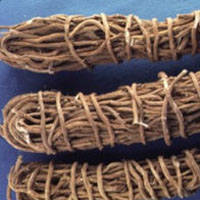Sarsaparilla
Uses
Parts Used & Where Grown
Many different species are called by the general name sarsaparilla. Various species are found in Mexico, South America, and the Caribbean. The root is used in herbal medicine.
Our proprietary “Star-Rating” system was developed to help you easily understand the amount of scientific support behind each supplement in relation to a specific health condition. While there is no way to predict whether a vitamin, mineral, or herb will successfully treat or prevent associated health conditions, our unique ratings tell you how well these supplements are understood by the medical community, and whether studies have found them to be effective for other people.
For over a decade, our team has combed through thousands of research articles published in reputable journals. To help you make educated decisions, and to better understand controversial or confusing supplements, our medical experts have digested the science into these three easy-to-follow ratings. We hope this provides you with a helpful resource to make informed decisions towards your health and well-being.
3 StarsReliable and relatively consistent scientific data showing a substantial health benefit.
2 StarsContradictory, insufficient, or preliminary studies suggesting a health benefit or minimal health benefit.
1 StarFor an herb, supported by traditional use but minimal or no scientific evidence. For a supplement, little scientific support.
This supplement has been used in connection with the following health conditions:
| Used for | Why |
|---|---|
1 Star Eczema Refer to label instructions | Sarsaparilla has been used historically to treat people with eczema. Burdock, , red clover, and wild oats have been used historically to treat people with eczema, but without scientific investigation. |
Traditional Use (May Not Be Supported by Scientific Studies)
In Mexico, sarsaparilla was used by herbalists for rheumatism, cancer, skin diseases, and a host of other conditions.1 At the turn of the 20th century, there were reports of its use by herbalists for the treatment of leprosy.2 Sarsaparilla also has a tradition of use in various women’s health concerns and was rumored to have a progesterone-like effect. Sarsaparilla was formerly a major flavoring agent in root beer.
How It Works
Sarsaparilla contains steroidal saponins, such as sarsasapogenin, which may mimic the action of some human hormones. This property remains undocumented, however. Sarsaparilla also contains phytosterols, such as beta-sitosterol, which may contribute to the anti-inflammatory effect of this herb. Reports have shown anti-inflammatory3 and liver-protecting4 effects for this herb. Similar reports on the effect of sarsaparilla on psoriasis occur in early European literature.5
How to Use It
Sarsaparilla is often taken in capsules, 2–4 grams three times per day.6 A tincture, 2–4 ml three times per day, may also be used.
Interactions with Supplements, Foods, & Other Compounds
Interactions with Medicines
Certain medicines interact with this supplement.
Replenish Depleted Nutrients
none
Reduce Side Effects
none
Support Medicine
none
Reduces Effectiveness
none
Potential Negative Interaction
- Digoxin
Sarsaparilla may increase the absorption of digitalis and bismuth, increasing the chance of toxicity.
Explanation Required
none
Side Effects
According to the German Commission E monograph, sarsaparilla may cause stomach irritation and temporary kidney irritation.7 Sarsaparilla should not be taken during pregnancy or breast feeding.
1. Duke JA. CRC Handbook of Medicinal Herbs. Boca Raton, FL: CRC Press, 1985, 446.
2. Bradley PR (ed). British Herbal Compendium, vol 1. Bournemouth, Dorset, UK: British Herbal Medicine Association, 1992, 194-6.
3. Ageel AM, Mossa JS, Al-Yahya MA, et al. Experimental studies on antirheumatic crude drugs used in Saudi traditional medicine. Drugs Exp Clin Res 1989;15:369-72.
4. Rafatullah S, Mossa JS, Ageel AM, et al. Hepatoprotective and safety evaluation studies on sarsaparilla. Int J Pharmacognosy 1991;29:296-301.
5. Hobbs C. Sarsaparilla, a literature review. HerbalGram 1988;17:1, 10-5 [review].
6. Blumenthal M, Busse WR, Goldberg A, et al. (eds). The Complete Commission E Monographs: Therapeutic Guide to Herbal Medicines. Boston, MA: Integrative Medicine Communications, 1998, 372-3.
7. Blumenthal M, Busse WR, Goldberg A, et al. (eds). The Complete Commission E Monographs: Therapeutic Guide to Herbal Medicines. Boston, MA: Integrative Medicine Communications, 1998, 372-3.
Last Review: 03-24-2015

Copyright © 2024 TraceGains, Inc. All rights reserved.
Learn more about TraceGains, the company.
The information presented by TraceGains is for informational purposes only. It is based on scientific studies (human, animal, or in vitro), clinical experience, or traditional usage as cited in each article. The results reported may not necessarily occur in all individuals. For many of the conditions discussed, treatment with prescription or over the counter medication is also available. Consult your doctor, practitioner, and/or pharmacist for any health problem and before using any supplements or before making any changes in prescribed medications. Information expires December 2024.
This information does not replace the advice of a doctor. Ignite Healthwise, LLC, disclaims any warranty or liability for your use of this information. Your use of this information means that you agree to the Terms of Use. Learn how we develop our content.

